360 Reality Audio virtualization works great on headphones, but not from this speaker.
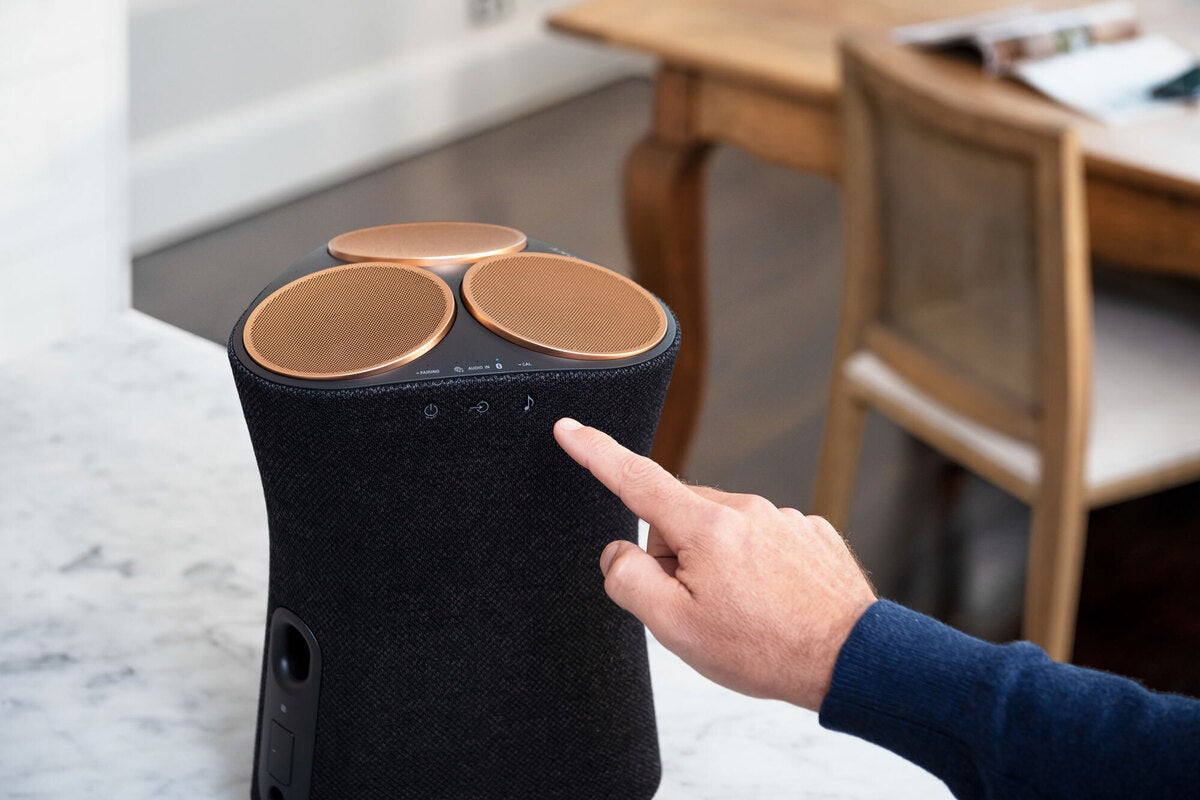
Sony
Today’s Best Tech Deals
Picked by TechHive’s Editors
Top Deals On Great Products
Picked by Techconnect’s Editors
Sony SRS-RA5000 wireless speaker
When I first heard Sony’s 360 Reality Audio technology at CES 2019, I was quite impressed with its implementation on headphones. The company was also demonstrating 360RA on a specially designed speaker, but the line to get into the demo booth was long, and my time at that point was very short, so I missed hearing what it could do from a speaker in a room.
About a year later, I wrote a full review of 360RA on headphones with a detailed explanation of the technology. More recently, I wrote an update on Sony’s plans for and demos of the technology at virtual CES 2021. But I still hadn’t experienced the technology from a speaker—until now.
Sony just introduced two 360 Reality Audio speakers—the SRS-RA5000 ($699.99) and the smaller SRS-RA3000 ($299.99). The company sent me an RA5000, and after listening to a variety of content, I have to say it’s quite underwhelming.
This review is part of TechHive’s coverage of the best Bluetooth speakers, where you’ll find reviews of the competition’s offerings, plus a buyer’s guide to the features you should consider when shopping for this type of product.
Features
To reiterate the basic idea, Sony’s 360 Reality Audio is an object-based, immersive-audio system, not unlike Dolby Atmos or DTS:X in principle, though its intended application is music rather than soundtracks. Content creators mix audio tracks using immersive-audio tools, placing instruments anywhere within a virtual 3D space. The final mix is encoded in MPEG-H, an audio codec that supports immersive audio.
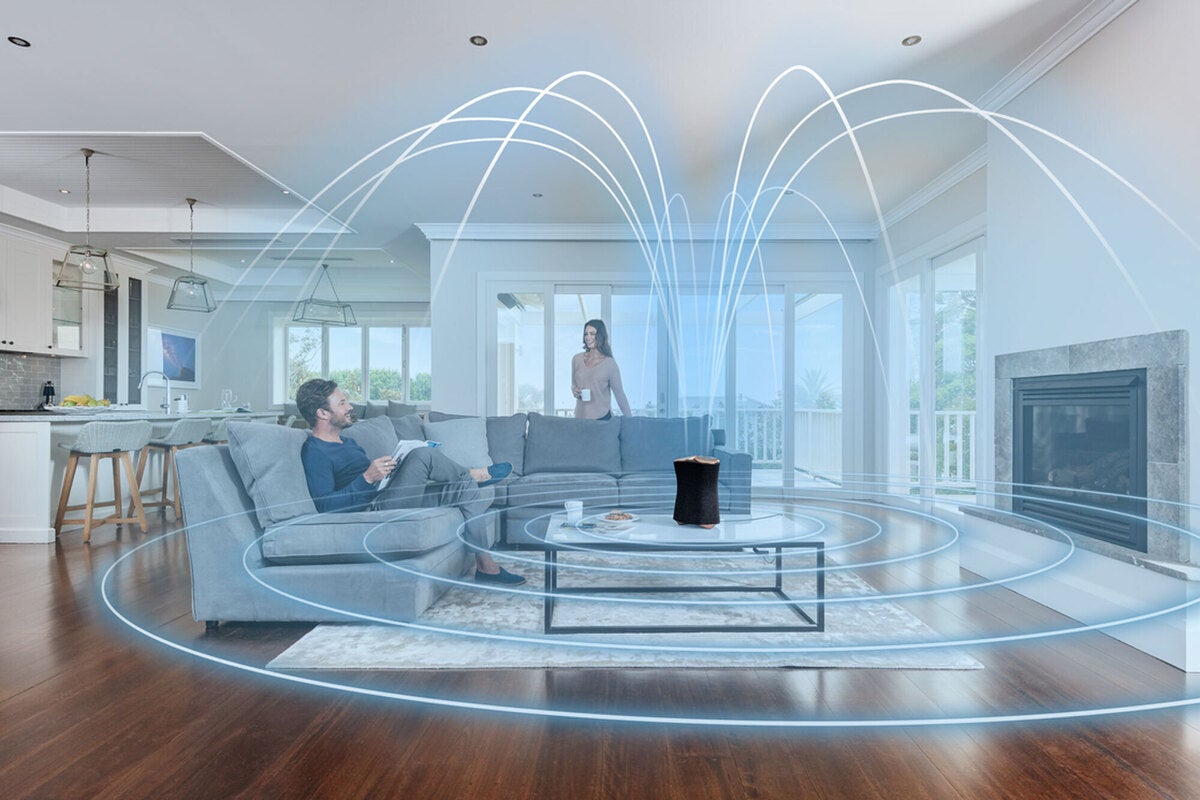 Sony
SonyThis illustration of the soundfield is somewhat misleading; sound waves certainly do not bend as seen here, though I suppose you could interpret the graphic as sound waves from the top drivers reflecting from the ceiling.
Music mixed and encoded as 360 Reality Audio is delivered via streaming providers. Currently, three providers offer 360RA titles for headphones and the new Sony speakers—Tidal, Deezer, and Nugs—while Amazon Music HD will start offering 360RA tracks for the Sony speakers starting on April 6, 2021, using Alexa Cast. Of course, each of these providers charges a subscription fee to access their catalog, though they also offer a free trial to check them out. As of this writing, there are a total of about 4,000 new and classic tracks that have been mixed or remixed in the 360RA format and generally delivered at a bit rate of around 1.5Mbps or less, depending on the provider.
The SRS-RA5000 looks like an overgrown three-head electric shaver, standing 13 inches tall by roughly nine inches across and weighing in at a hefty 10.8 pounds. The slightly hourglass-shaped sides are covered with heavy-duty grille cloth.
 Sony
SonyThe top of the speaker holds three drivers that fire upward.
Three drivers on top of the speaker fire upward, while three more drivers behind the grille cloth fire sideways at an angle of 120 degrees from each other, generating an omnidirectional soundfield. Each of these six drivers measures 1.8 inches in diameter, and they are enclosed in a sealed chamber. A single downfiring woofer measures 2.75 inches in diameter and sits in a ported chamber. Each driver has 30 watts of power behind it, but I could not find any frequency-response specs, and Sony did not provide them after repeated requests.
One important feature is called Immersive Audio Enhancement (I, which processes 2-channel stereo tracks and renders them in the omnidirectional soundfield. This is intended to simulate the effect of 360 Reality Audio with non-encoded files.
Another cool feature is room calibration. When you initiate this function, the speaker plays a short series of tones, and a built-in microphone picks up the reflections in the room. That information is then used to optimize the speaker’s performance for the acoustic environment.
As you might expect, the primary input mode is wireless. The RA-5000 supports Bluetooth 4.2 (why not 5.0?) using the A2DP and AVRCP profiles with the SBC and AAP codecs (no aptX or any of its variants). Unfortunately, it does not support Apple’s AirPlay.
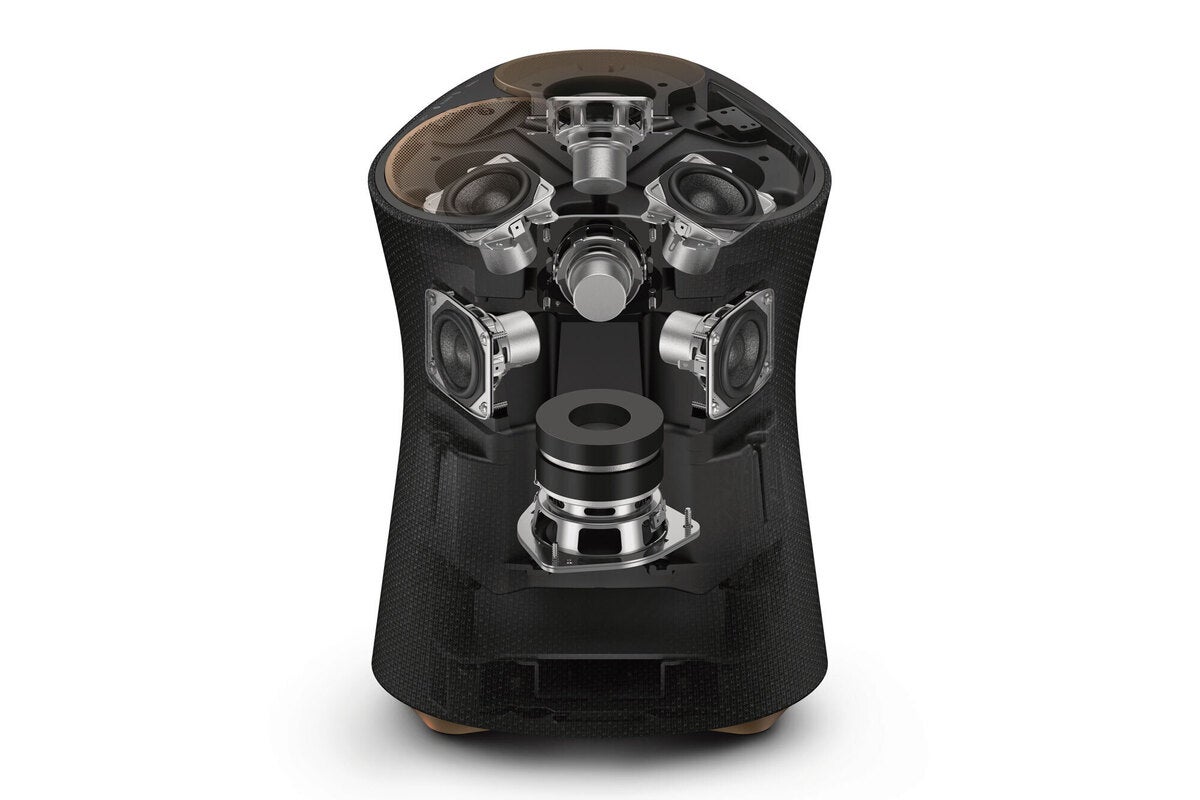 Sony
SonyHere you can see the internal structure of the SRS-RA5000, with three upfiring drivers, three sidefiring drivers, and one downfiring woofer.
On the plus side, the speaker can connect directly to your Wi-Fi network and access streaming services via Chromecast or Alexa Cast. You can also add the RA5000 to a speaker group in the Google Home App or a Multi-Room Audio setup in the Alexa app for whole-home audio. In addition, it’s compatible with Google Assistant or Alexa voice commands to the appropriate connected devices; its microphone isn’t used to accept voice commands directly.
The rear of the speaker contains the only physical audio connector—a 3.5 mm aux input—below the woofer port. The AC power connector is found on the bottom of the speaker, whose feet lift it high enough to allow the cable to pass through to an AC outlet.
User interface
Two groups of touch-sensitive controls are located near the top of the speaker. One group includes a Bluetooth pairing button (which confusingly uses the standard power on/off icon rather than the Bluetooth icon), an audio-input selector, and a button that initiates the short room-calibration routine. The Bluetooth button has an associated LED that indicates pairing status, while the input selector has three LEDs that indicate which input is selected.
The other group of controls includes a play/pause button as well as volume up and down buttons. An LED above these controls lights up when the speaker is connected to AC power; there is no power on/off switch.
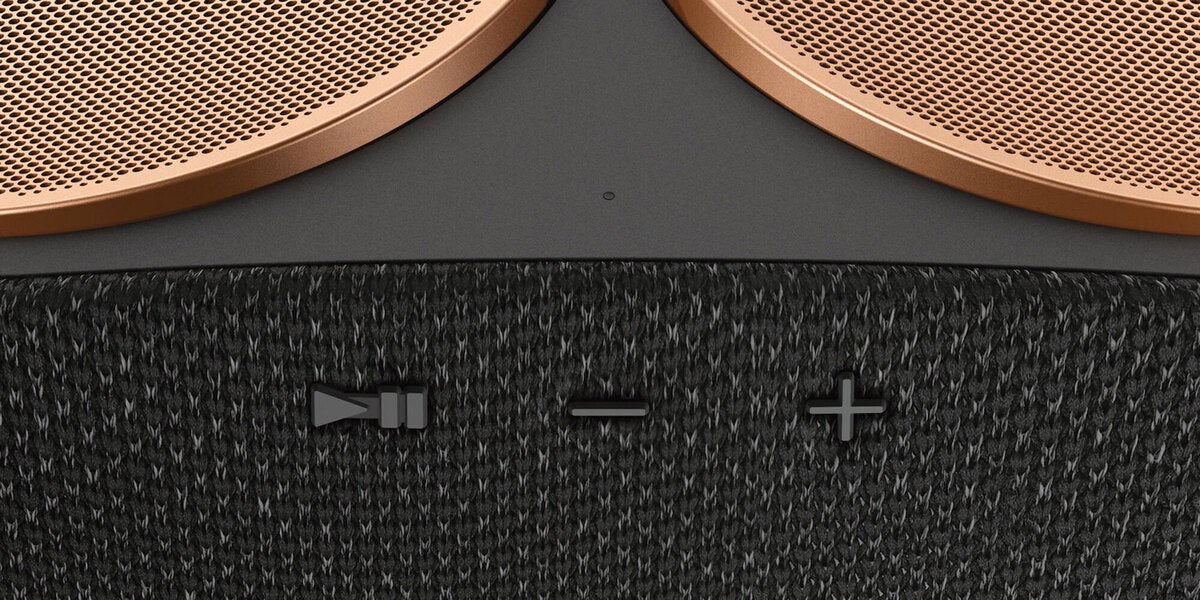 Sony
SonyThe other set of controls include (L-R) play/pause, volume up, and volume down.
But the primary user interface is Sony’s Music Center app, which is available for iOS and Android devices. After adding the speaker to the app, you can select the input, adjust the volume, and directly access various streaming providers, including Pandora, Qobuz, Spotify, and Tidal, as well as your personal music library. I’m astonished that the app does not provide direct access to Deezer or Nugs, which offer 360RA-encoded tracks along with Tidal, while Pandora, Qobuz, and Spotify do not support 360RA.
A variety of settings and information is also available in the app. In particular, the Sound settings include a five-band graphic equalizer (63Hz, 250Hz, 1kHz, 4kHz, 16kHz) with four presets (Bass, Excited, Bright, Vocal) and a Custom setting that lets you set the boost or cut for each band. You can also enable or disable IAE and initiate room calibration. In addition, you can adjust the level of the upfiring drivers and engage or disengage auto volume.
 Scott Wilkinson / IDG
Scott Wilkinson / IDGHere are two of the EQ presets for the RA5000, plus my Custom setting. “Bass” (left) makes the already boomy bass worse, while “Bright” (center) makes the sound quite buzzy. My Custom setting (right) got the best result with most music.
You set up the SRS-RA5000 with the Sony Music Center app and either Alexa or Google Home; I chose Google Home using my iPhone XS. The process was pretty straightforward, connecting the phone to the speaker and the speaker to my Wi-Fi network. I also needed to pair the speaker with my phone via Bluetooth.
The speaker performs its room-calibration routine when you first connect it to AC power. You can also initiate the routine from the Music Center app or the onboard button any time you change its location.
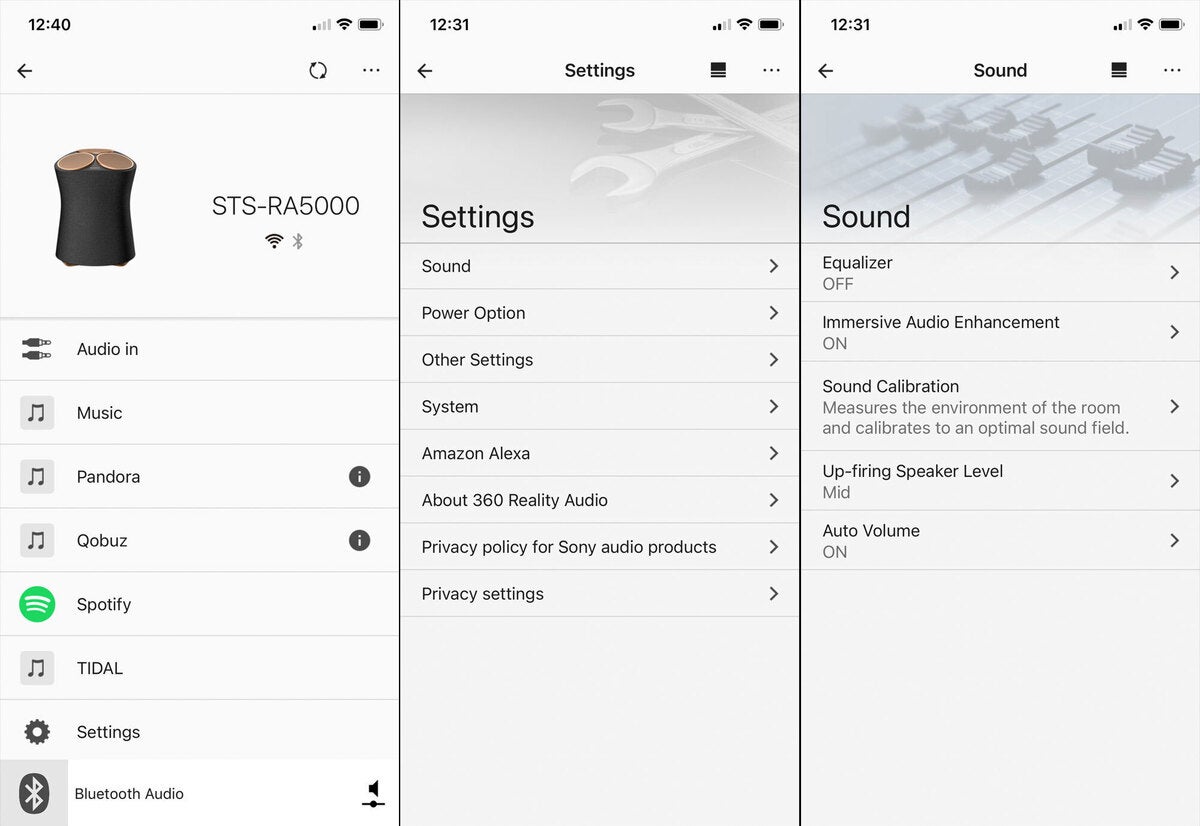 Scott Wilkinson / IDG
Scott Wilkinson / IDGSony’s Music Center app main screen (left) provides direct access to the aux-audio input, your local music library, and streaming services. It also provides access to the settings and indicates the current input at the bottom. The Settings screen (center) offers a variety of settings and information, while the Sound settings (right) let you adjust the equalizer, turn Immersive Audio Enhancement on and off, initiate room calibration, adjust the level of the up-firing speakers, and turn Auto Volume on and off.
360 Reality Audio tracks
I used Tidal via Bluetooth for most of my listening, and I started with the RA5000 on a coffee table in my fairly large living room, well away from any walls. Since 360 Reality Audio from a speaker such as this one is supposed to replicate a live-concert experience, I started with the 360RA version of “Evil Ways” by Carlos Santana from Carlos Santana & Buddy Miles Live!. Unfortunately, the sound was pretty bad—it appeared to come mostly from the speaker with virtually no expansive soundfield. In addition, it sounded muddy and congested with tubby, boomy bass. Fiddling with the graphic EQ helped the bass a bit.
Next, I tried the 2-channel version of the same track. With Immersive Audio Enhancement (IAE) on, I had the same complaints. Turning IAE off, the sound actually cleaned up somewhat, though it was thinner with a very different tonal character, and the soundstage became even smaller.
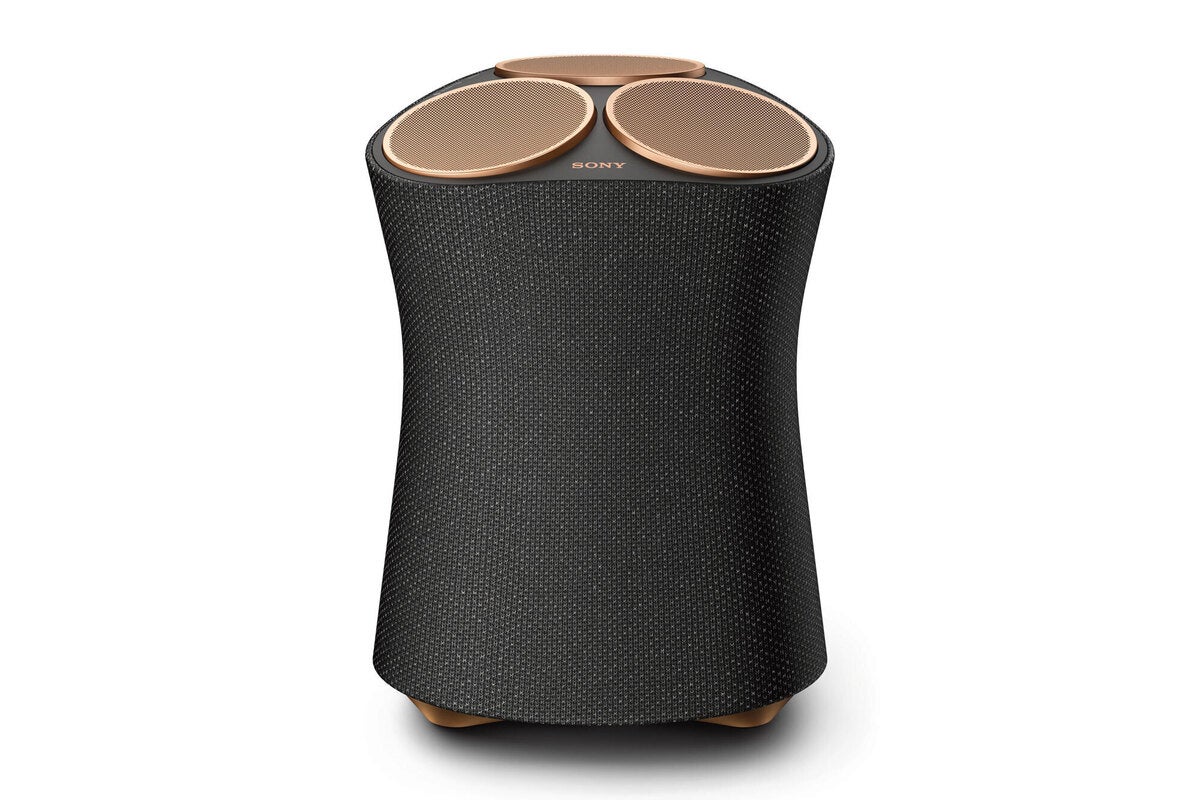 Sony
SonyThe SRS-RA5000 looks like an overgrown 3-head electric shaver with a slightly hourglass shape.
Wondering if things might improve in a smaller, more box-like room, I moved the speaker into my home theater, put it on a stand in the middle of the room, and ran the calibration routine again. Starting with the 360RA version of “Go to Hell, For Heaven’s Sake” by Bring Me the Horizon from Live at The Royal Albert Hall, things did not improve. The bass was bloated, especially the bass drum, and the low-midrange was quite congested. And the sound appeared to be coming almost entirely from the speaker, not a big, immersive soundfield.
In playing with the EQ during this track, I found that the Bass and Excited presets boost the bass, which made the sound worse. The Vocal preset boosts 1kHz and 4kHz slightly, which helped a bit, while Bright boosts 4kHz and 16kHz strongly, which was like running a chainsaw. The best result was cutting 63- and 250Hz and boosting 1-, 4-, and 16kHz a bit. That reduced the bass bloat, but of course, it did nothing to expand the soundfield.
Next up was the 360RA version of “Peter Pan” by country singer Kelsea Ballerini from The First Time. Muddy, boomy bass dominated the congested, dull sound, and the vocals were rather thin. My custom EQ settings helped a bit, but not all that much, and the sound appeared to come mostly from the speaker with virtually no expansive soundstage.
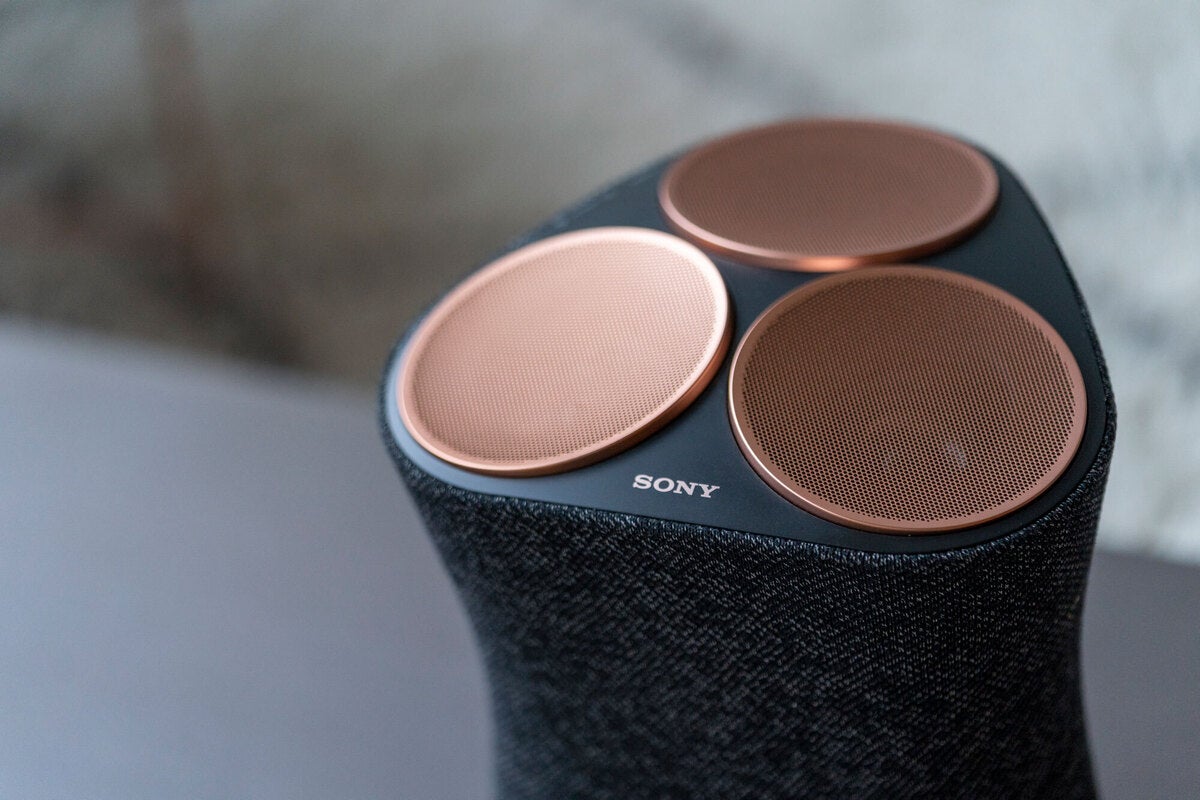 Sony
SonySony’s SRS-RA5000 wireless speaker supports both Bluetooth and Wi-Fi.
For some modern rock, I listened to the 360RA version of “Making a Fire” by Foo Fighters from Medicine at Midnight. With the EQ off, the bass was super-tubby, and the rest of the sound was pretty muddy. My custom EQ settings helped, but the low midrange was still congested.
I was happy to find Tower of Power’s Ain’t Nothin’ Stoppin’ Us Now in 360RA, so I cued up “Deal With It.” As before, the bass was bloated and tubby, overpowering everything else. EQ helped some, but it was still congested in the low midrange.
Dave Brubeck’s classic “Take Five” from Time Out was one of the early 360RA releases. On the RA5000, the bass was bloated, and Paul Desmond’s sweet alto sax sounded very artificial. The congestion was not as bad as on the other tracks I sampled, perhaps because there are only four instruments, but it was still there in the low midrange. EQ helped a bit, and I didn’t need to cut 63- and 250Hz as much.
2-channel tracks
In addition to 360RA-encoded tracks, I listened to several 2-channel stereo tracks from Tidal’s Master library to test the RA5000’s Immersive Audio Enhancement (IAE). Starting with some jazz, I played “I Had a Dream” by Chris Potter from There is a Tide. Without IAE, the sound was somewhat thin, but the bass was not bloated or overblown, and the soundstage was confined entirely to the speaker. Turning IAE on, the tonal character changed dramatically—the horns and sax solo sounded quite artificial, the bass was more prominent, and the low midrange was congested. On the plus side, the soundstage noticeably expanded, though most of it still appeared to come from the speaker.
Lately, I’ve been on a Dan Hicks and His Hot Licks kick, so I listened to “I Scare Myself” (featuring Ricki Lee Jones) from Beatin’ the Heat. As before, with IAE off, the sound was relatively thin and coming entirely from the speaker. With IAE on, the vocals were much more obscured with congested low midrange, though the soundstage expanded somewhat.
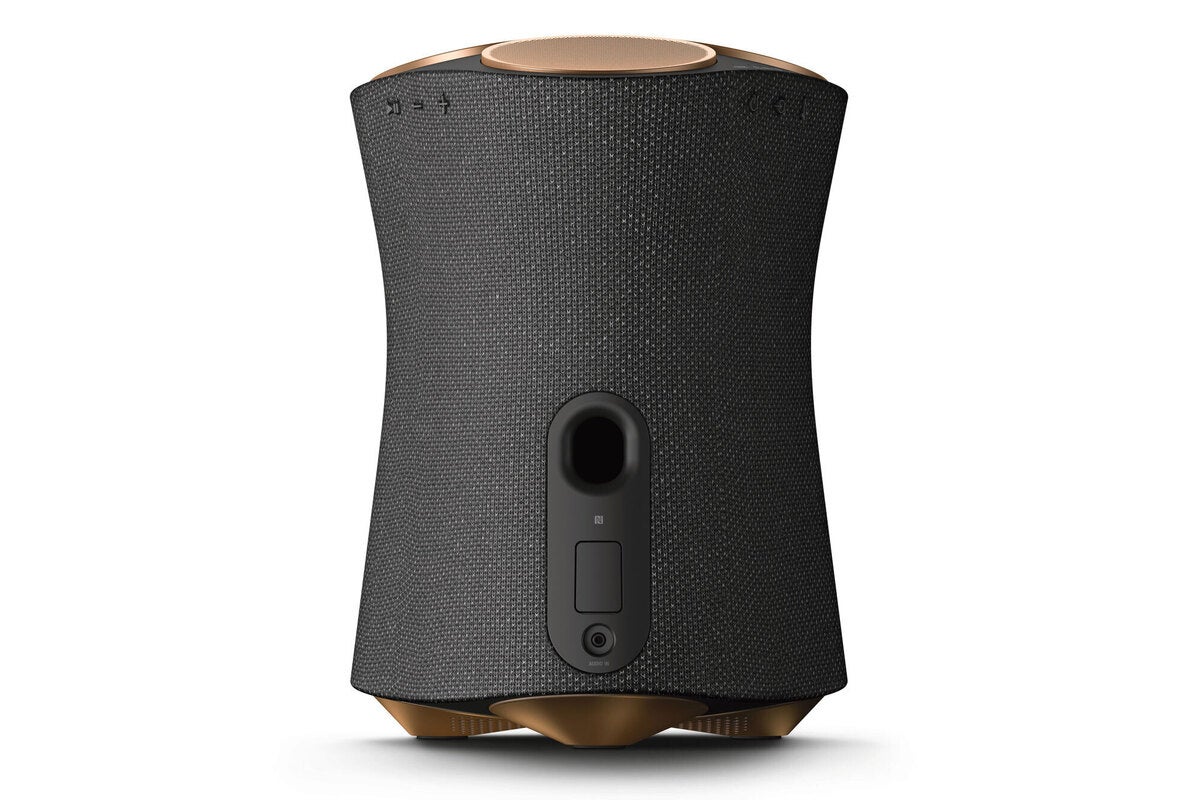 Sony
SonyA 3.5mm aux-audio input is found on the rear, along with the woofer port.
For a bit of classical, I listened to the first movement of Beethoven’s Piano Sonata No. 27 in E minor, Op. 90, as recorded by Daniel Barenboim. With IAE off, it had a thin sound with a congested low midrange. Turning IAE on brightened the sound and enlarged the soundfield, but it was still a bit muddy. Even so, I preferred IAE on in this case.
Turning to full orchestra, I played the finale of Stravinsky’s The Firebird as recorded by the Philharmonia Orchestra under the direction of Robert Craft. Starting with IAE off, the sound was closed in and congested, especially the low midrange. When I turned IAE on, the soundstage expanded quite a bit, but the tonal character was very different, and the low midrange was still congested.
Qobuz via Wi-Fi
To test the RA5000’s performance via Wi-Fi, I streamed some tracks from Qobuz using Chromecast. Qobuz does not have any 360RA-encoded content—some users have created playlists labeled 360 Reality Audio, even though they are not—so I listened to some high-res stereo tracks.
Before I started this series of evaluations, I had put the RA5000 was on the carpeted floor, and I inadvertently started playing some music without returning it to the stand. That was fortuitous, because I thought the sound quality noticeably improved. Perhaps it was the more direct sound from the upfiring drivers and/or the larger reflecting yet absorbent surface of the floor—whatever the reason, I much preferred the sound of the speaker in that position.
 Sony
SonySony’s SRS-RA5000 is a big speaker, measuring 13 inches tall and tipping the scales at nearly 11 pounds.
I started with “Hershey Bar” by the David Angel Jazz Ensemble from Out on the Coast. With IAE off, the sound was very congested, and as expected, the soundfield was entirely within the speaker. Turning IAE on, the soundfield expanded quite a bit, and the sound was more open. As before, the tonal character was drastically different, but I liked it better with IAE on. Still, most of the sound appeared to come from the speaker.
I have almost the same notes for “Chameleon” by Herbie Hancock from Head Hunters, “Take Five” from Dave Brubeck’s Time Out, and “Birds of Fire” by the Mahavishnu Orchestra from The Essential Mahavishnu Orchestra. In each case, turning IAE on expanded the soundstage, causing some sounds to appear to come from outside the speaker cabinet, but I still wouldn’t call it truly immersive. And the sound quality opened up, with less congestion and a richer—though very different—tonal character.
Bottom line
I’m sorry to say I was disappointed in the performance of the SRS-RA5000. The 360 Reality Audio tracks I played did not present a sweeping, immersive soundstage as promised; the effect is much more pronounced in headphones as I discovered in my previous review of the technology. And the sound quality was not great—boomy, overbearing bass and muddy, congested low midrange.
While the number of 360RA tracks is increasing—by a factor of four in the last year—4,000 is still only a tiny fraction of the millions of tracks available from streaming services, and I could find no classical tracks at all. So, much of the content owners will listen to is stereo audio. With IAE off, the RA5000 sounds thin and closed in with a tiny soundstage entirely within the speaker. Turning IAE on expands the soundstage and opens up the sound somewhat, but it dramatically changes the tonal character. Interestingly, I got the best sound when the speaker was on the floor, but this is undoubtedly impractical for many situations.
Then there’s the price—a penny less than $700 is not chump change for a wireless speaker. If it really did create a huge, immersive soundstage with good sound quality, I’d say it’s definitely worth that much. But as it is, not so much.
Note: When you purchase something after clicking links in our articles, we may earn a small commission. Read our affiliate link policy for more details.
Sony SRS-RA5000 wireless speaker
The SRS-RA5000 promises a big, immersive, concert-like soundstage from a single speaker—especially with 360 Reality Audio tracks—but it fails to deliver.
Pros
- IAE expands sound field of stereo tracks to some degree
- EQ can help improve sound quality somewhat
- Works best on the floor
Cons
- Muddy, congested sound, especially in the low midrange
- Boomy, overbearing bass
- 360RA tracks do not present a truly expansive, immersive sound field
- Stereo tracks with IAE off sound thin and closed in
- IAE dramatically alters the tonal profile of stereo tracks

